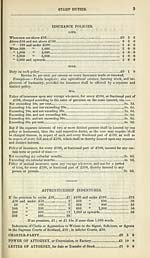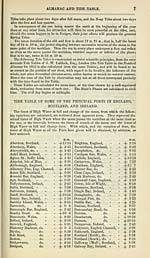Download files
Complete book:
Individual page:
Thumbnail gallery: Grid view | List view

ALMANAC AND TIDE TABLE.
From June, 1853, till June, 1854.
The daily rising and falling of the waters of the ocean are, in general, denominated
Tides. The rising is called the Flood, or Flux ; and when it ceases to rise, High
Water. The falling is called the Ebb, or Reflux ; and when it ceases to fall, it is
said to be Low Water. The interval between the times of High and Low Water is
called a Tide.
The Tides are produced by the attraction of the sun and moon, principally that
of the latter object. The cohesion of fluids being much less than that of solid bodies,
they more easily yield to the power of gravity; in consequence of which the waters
immediately below the moon are drawn up in a protuberance, producing a full tide,
or what is commonly called High Water, at the spot where it happens. According
to this theory, you would imagine that we should have full tide only once in twenty-
four hours, that is, every time that we were below the moon ; while we find that we
have two tides in the course of twenty-four hours, and that it is High Water with
us, and with our antipodes at the same time.
This opposite tide is rather more difficult to explain than that which is drawn up
beneath the moon. In order to render the questi >n more simple, let us suppose the
earth to be everywhere covered by the
ocean, as in the following figure.
M is the moon, ABCI) the earth.
Now. the waters on the surface of the
earth about A being more attracted
than in any other part, will be ele-
vated, the attraction of the moon at
B and C being less ; but still it will
be greater there than at I), which is
c the part most distant from the moon.
The body of the earth will therefore be drawn away from the waters at D, leaving
a protuberance similar to that at A : so that the tide, A, is produced by the waters
receding from the earth, and the tide, D, by the earth receding from the waters.
The influence of the sun on the tides is less than that of the moon; for, observe,
that the tides rise in consequence of the moon attracting one part of the waters more
forcibly than another part. It is this inequality of attraction which produces full
and ebb tides. Now, the distance of the sun is so fjreat, that the whole y;'obe of the
earth is comparatively but as a point; and the difference of its attraction for that
part of the waters most under its influence, and that part least subject to it, is but
trifling. No part of the waters will be much elevated above, or much depressed
below, their general surface by its action. The sun has, however, a considerable
effect on the tides; and increases or diminishes them as it acts in conjunction with,
or in opposition to, the moon.
According to the calculations of the celebrated La Place, in his Mecanique Celeste,
the mean force of the sun in raising the tides is to the mean force of the moon as 1
to 1^ ; and Emerson, in page 423, second edition of his Treatise on Fluxions, calcu-
lates the height of the solar tide to be 1:63 feet, and the height by the moon's
influence to be 7 - 28 feet; consequently, the height of their joint force to be 8 91 feet.
The height here calculated is S'pposed to be at such places where the sun and moon
are vertical, and also in the equinoctial. In places at a distance from the equator,
the height will be less as the latitude is greater. Further, their height wiil also be
less according to the sun and moon's declination from the equator.
From what has already been remarked regarding the tides, it is obvions that,
when the moon is in Perigee, or at her nearest distance from the earth, she attracts
strongest, and therefore raises the tides most. The contrary happens when she is in
Apogee, or at her greatest distance from the earth, because of her weaker attraction.
At new moon, when she is in conjunction with the sun, and at full moon, when they
are in opposition, the tides are raised by the joint attraction of both luminaries, and
therefore will produce the highest, or what are called Spring Tides. And Neap
Tides are produced by the difference of their force when in quadrature. The Spring
From June, 1853, till June, 1854.
The daily rising and falling of the waters of the ocean are, in general, denominated
Tides. The rising is called the Flood, or Flux ; and when it ceases to rise, High
Water. The falling is called the Ebb, or Reflux ; and when it ceases to fall, it is
said to be Low Water. The interval between the times of High and Low Water is
called a Tide.
The Tides are produced by the attraction of the sun and moon, principally that
of the latter object. The cohesion of fluids being much less than that of solid bodies,
they more easily yield to the power of gravity; in consequence of which the waters
immediately below the moon are drawn up in a protuberance, producing a full tide,
or what is commonly called High Water, at the spot where it happens. According
to this theory, you would imagine that we should have full tide only once in twenty-
four hours, that is, every time that we were below the moon ; while we find that we
have two tides in the course of twenty-four hours, and that it is High Water with
us, and with our antipodes at the same time.
This opposite tide is rather more difficult to explain than that which is drawn up
beneath the moon. In order to render the questi >n more simple, let us suppose the
earth to be everywhere covered by the
ocean, as in the following figure.
M is the moon, ABCI) the earth.
Now. the waters on the surface of the
earth about A being more attracted
than in any other part, will be ele-
vated, the attraction of the moon at
B and C being less ; but still it will
be greater there than at I), which is
c the part most distant from the moon.
The body of the earth will therefore be drawn away from the waters at D, leaving
a protuberance similar to that at A : so that the tide, A, is produced by the waters
receding from the earth, and the tide, D, by the earth receding from the waters.
The influence of the sun on the tides is less than that of the moon; for, observe,
that the tides rise in consequence of the moon attracting one part of the waters more
forcibly than another part. It is this inequality of attraction which produces full
and ebb tides. Now, the distance of the sun is so fjreat, that the whole y;'obe of the
earth is comparatively but as a point; and the difference of its attraction for that
part of the waters most under its influence, and that part least subject to it, is but
trifling. No part of the waters will be much elevated above, or much depressed
below, their general surface by its action. The sun has, however, a considerable
effect on the tides; and increases or diminishes them as it acts in conjunction with,
or in opposition to, the moon.
According to the calculations of the celebrated La Place, in his Mecanique Celeste,
the mean force of the sun in raising the tides is to the mean force of the moon as 1
to 1^ ; and Emerson, in page 423, second edition of his Treatise on Fluxions, calcu-
lates the height of the solar tide to be 1:63 feet, and the height by the moon's
influence to be 7 - 28 feet; consequently, the height of their joint force to be 8 91 feet.
The height here calculated is S'pposed to be at such places where the sun and moon
are vertical, and also in the equinoctial. In places at a distance from the equator,
the height will be less as the latitude is greater. Further, their height wiil also be
less according to the sun and moon's declination from the equator.
From what has already been remarked regarding the tides, it is obvions that,
when the moon is in Perigee, or at her nearest distance from the earth, she attracts
strongest, and therefore raises the tides most. The contrary happens when she is in
Apogee, or at her greatest distance from the earth, because of her weaker attraction.
At new moon, when she is in conjunction with the sun, and at full moon, when they
are in opposition, the tides are raised by the joint attraction of both luminaries, and
therefore will produce the highest, or what are called Spring Tides. And Neap
Tides are produced by the difference of their force when in quadrature. The Spring
Set display mode to: Large image | Transcription
Images and transcriptions on this page, including medium image downloads, may be used under the Creative Commons Attribution 4.0 International Licence unless otherwise stated. ![]()
| Scottish Post Office Directories > Towns > Glasgow > Post-Office annual Glasgow directory > 1853-1854 > (26) |
|---|
| Permanent URL | https://digital.nls.uk/84108684 |
|---|
| Description | Directories of individual Scottish towns and their suburbs. |
|---|
| Description | Around 700 Scottish directories published annually by the Post Office or private publishers between 1773 and 1911. Most of Scotland covered, with a focus on Edinburgh, Glasgow, Dundee and Aberdeen. Most volumes include a general directory (A-Z by surname), street directory (A-Z by street) and trade directory (A-Z by trade). |
|---|


